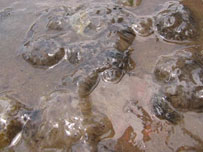
Bryozoan are invertebrate animals that reproduce by budding.
The creatures appeared in the Rung Lake in Tu Trung Commune in the province's Vinh Tuong District last May, but have proliferated on a large scale recently.
The provincial environmental research center, which is also tasked with preventing diseases at fisheries informed the Binh Minh Cooperative, which manages and exploits the lake, that the creatures are a fresh water bryozoan named Pectinatella magnifica.
The tiny colonial creatures generally build mucilaginous (moist and sticky) structures of gelatin with 99 percent water, that look like a flower with a diameter of up to two meters, the center reported.
The structures can stick to underwater plants and move at a speed of 1-1.5 millimeters a day.
The center's director, Phan Thi Van, said she had instructed local authorities not to drain water out of the lake to prevent the spread of the bryozoan.
Le Thanh Luu, director of the Research Institute for Aquaculture No. 1, said this is the first time the creature has been found in Vietnam.
Phan Thi Xuan, chairman of the Binh Minh Cooperative said the fresh water lake collects rainwater with an average depth of 3.5 meters, with its deepest point at eight meters.
The Rung Lake is the irrigation source for farms in four communes of Vinh Phuc Province's Vinh Tuong District - Tu Trung, Tam Phuc, Phu Da and Ngu Kien. It also supplies water to some smaller lakes and ponds.
"It's very important to prevent the spread of the creatures as the lake is a source of water for many places," Xuan said.
Strange creatures
She said she thought it was an impact of changing weather when fish in the lake started to die in large numbers last October.
Last month, the cooperative started to collect fish in the lake and caught around two tons of the "strange" creature. Most of the fish in the net weakened before dying.
"Not only did the fish die, many people who touched the creatures suffered itchiness and sore eyes," she said.
"We didn't know if they were animals or plants and began called them the "strange creature," Xuan said.
She showed a bucket containing some bryozoans, adding that they had died after being caught a day earlier.
Yen, a worker at the cooperative, said the strange creatures stick themselves to the plants, bags, or the lake floor. He also said some were as small as a finger-tip but others weighed almost a kilogram.
Researchers feel the fish may have died after coming into contact with the bryozoans, causing the mucous substance to stick to their gills.
They have found that the water in the lake is not polluted and is suitable for breeding fish.
Further studies are being carried out to verify the creatures' possible toxicity as well as their origin, she said.



Uh-oh.